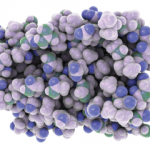inflammatory cytokines like type 1 interferon, and interleukin (IL) 1 and IL-18.
Type 1 Interferons
Type 1 interferons play a role in lupus pathogenesis, because increased levels of IFN-α are found in the serum of SLE patients.2 Complexes of immunoglobulin G (IgG) and nucleic acids stimulate interferon production by plasmacytoid dendritic cells (pDCs) and B cell activation, he said. IFN-α in lupus serum promotes monocyte maturation to dendritic cells, and there is an interferon-induced gene expression signature in the peripheral blood and affected tissues in lupus patients. Patients with malignancies or viral infections who are treated with IFN-α sometimes develop lupus-like symptoms, he said.
In a 2003 study, predisposed NZB mice were bred to lack the common receptor for type 1 interferons.3 These IFNAR-knockout NZB mice had lower mortality and profoundly reduced signs of lupus-like disease, such as anti-erythrocyte and anti-DNA autoantibodies, compared with wild-type mice, he said. In a 2012 study, NZB mice were bred to lack IFN-β to see if either it or any of the 13 IFN-α proteins mediated lupus-like disease.4 The results showed that mice with deleted IFN-β did develop disease.
“This suggests that the pathogenic effect of interferons is primarily mediated by the alpha types. Then, we set out to find if such a treatment would have any clinical relevance,” he said. In the 2012 study, researchers developed an antibody against the common receptor for type 1 interferon, called IFNAR, to treat the mice affected with lupus-like disease. The results were positive: antinuclear antibodies, anti-chromatins, kidney deposits and mononuclear cells were reduced, and the mice lived longer. “However, this treatment was initiated early in the disease process, around 12 weeks of age. If treatment was delayed to beyond 18 weeks of age, the protective effects were significantly minimized. This indicates that the role of type 1 interferons and pDCs is very likely exercised at the early stages of the disease. If we can translate these findings to the clinic, then treatment with anti-IFNAR should be complemented with additional treatments that interfere with the adaptive immune system.”
Toll-Like Receptors
To understand the role of the nucleic acid-sensing, endosomal TLRs 3, 7, 8 and 9 in lupus, researchers created mice with new, mutant version of the molecule UNC93B1 called 3d.5 Normally, this molecule binds to endosomal TLRs in the endoplasmic reticulum and then transports them into the endolysosomes, said Dr. Theofilopoulos. Mice with the UNC93B1 mutation had no signaling of endosomal TLRs, and disease characteristics were profoundly reduced in the mice that carried a duplication of TLR-7, he said. Later research showed that mice with this UNC93B1 3d mutation are protected from developing lupus-like disease, and the mutation seems to broadly reduce lupus autoantibodies like anti-cardiolipin, anti-β2 glycoprotein and anti-MPO, he said.6


